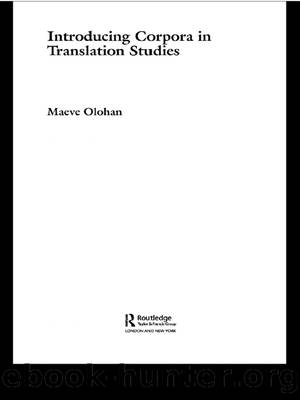Introducing Corpora in Translation Studies by Olohan Maeve;

Author:Olohan, Maeve;
Language: eng
Format: epub
Tags: ebook
Publisher: Taylor & Francis Group
Published: 2011-09-30T00:00:00+00:00
7.2.6 Co-occurrence of features
A study that can be discussed in the framework of both explicitation and normalization is Olohanâs (2003) study of contracted forms in translated fiction and biography texts (a subset of the TEC) compared with non-translations (a subset of the imaginative writing section of the BNC). Olohan and Baker (2000), in their study of the optional reporting that, state that the linguistics literature on use and omission of that with a range of verbs indicates omission to be more likely in informal contexts. Preliminary analysis of co-occurrence of that omission and contracted forms (as a crude measure of informality) is carried out and reveals a definite correlation in both corpora between use of contracted forms and omission of that (Olohan 2003: 63-4). Thus, despite lower incidence of contractions in the TEC subcorpus and higher incidence of that omission in the BNC subcorpus, the likelihood of co-occurrence of a contracted form and omission of that (in the same concordance line) is very similar in both corpora. In other words, the BNC texts are more likely to omit that and use contractions; the TEC texts are more likely to include that and not use contractions. This correlation suggests that contractions merit further investigation.
Further detailed analysis of all contracted forms in the corpora reveals that there are higher occurrences and a greater variety of contracted forms in the BNC subcorpus than in the TEC subcorpus (Olohan 2003: 64-81). In many cases, the number of occurrences of a form in the BNC subcorpus is double that seen in the TEC subcorpus, with both corpora very similar in terms of size and composition. In addition, there is a general preference for contracted forms over the corresponding long forms in the BNC texts, while the TEC data show a general tendency to use the long form in preference to the contracted one. For example, for allâs contractions (not including the possessiveâs (i.e. for the following forms: itâs, thatâs, heâs, thereâs, sheâs, whatâs, letâs, whoâs, whereâs, hereâs, howâs), the contracted form is significantly more common than the long form in the BNC subcorpus. This is not true for the TEC subcorpus, where the long form is the more frequent in eight out of the eleven forms. In the latter, the contracted form is more frequent only for thatâs, -whatâs, and letâs, but in these cases represents a smaller proportion of the combined total occurrences of long and contracted forms than does the long form in the BNC subcorpus.
Splitting the analysis into verbs, we can see from Figures 7.3, 7.4 and 7.5 that there is a greater incidence of contracted forms with personal pronouns in the BNC subcorpus than in the TEC subcorpus for present-tense forms of BE, HAVE and WILL.
As far as common not- contractions are concerned, the overall tendency in both corpora is to contract. However, the proportion of contracted forms is smaller in the TEC subcorpus than in the BNC data in all cases, and for two forms examined, couldnât and wouldnât, the TEC subcorpus is, in fact, more likely to use the long form.
Download
This site does not store any files on its server. We only index and link to content provided by other sites. Please contact the content providers to delete copyright contents if any and email us, we'll remove relevant links or contents immediately.
Cecilia; Or, Memoirs of an Heiress — Volume 1 by Fanny Burney(32046)
Cecilia; Or, Memoirs of an Heiress — Volume 3 by Fanny Burney(31448)
Cecilia; Or, Memoirs of an Heiress — Volume 2 by Fanny Burney(31398)
The Lost Art of Listening by Michael P. Nichols(7150)
We Need to Talk by Celeste Headlee(5407)
Asking the Right Questions: A Guide to Critical Thinking by M. Neil Browne & Stuart M. Keeley(5351)
On Writing A Memoir of the Craft by Stephen King(4657)
Dialogue by Robert McKee(4156)
Pre-Suasion: A Revolutionary Way to Influence and Persuade by Robert Cialdini(3968)
I Have Something to Say: Mastering the Art of Public Speaking in an Age of Disconnection by John Bowe(3774)
Elements of Style 2017 by Richard De A'Morelli(3234)
The Book of Human Emotions by Tiffany Watt Smith(3136)
Fluent Forever: How to Learn Any Language Fast and Never Forget It by Gabriel Wyner(2913)
Name Book, The: Over 10,000 Names--Their Meanings, Origins, and Spiritual Significance by Astoria Dorothy(2835)
Good Humor, Bad Taste: A Sociology of the Joke by Kuipers Giselinde(2821)
Why I Write by George Orwell(2771)
The Grammaring Guide to English Grammar with Exercises by Péter Simon(2644)
The Art Of Deception by Kevin Mitnick(2621)
Don't Sleep, There Are Snakes by Daniel L. Everett(2496)
